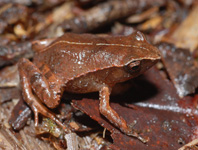Abstract
A new species of leiobunine harvestman from the Chiricahua Mountains of Arizona is described. The species lacks pro- and retrolateral submarginal rows of coxal denticles, a feature often considered diagnostic for the polyphyletic Nelima, and has greatly reduced ventral dentition on the palpal claw, as in the monotypic Leuronychus. In most other respects, the species is uniquely similar to members of a clade from central and western Mexico currently in the poly- and/or paraphyletic Leiobunum. These traits include a supracheliceral lamina with a wide transverse plate and a canaliculate ocularium, with an anterior surface that slopes dorsoposteriorly and a posterior surface that bulges rearward and is constricted at its base. There is thus a conflict between classification using traditional diagnostic characters and classification using unique similarity of non-traditional characters. The problem is exacerbated by the problematic status of each candidate genus. Here the species is placed in Leiobunum as L. silum sp. nov., a decision that gives weight to probable phylogenetic affinity with species currently placed in that genus. Leiobunum silum provides an excellent example of the limits of traditional typological classification and the need for a broad-scale morphological and molecular revision of sclerosomatid harvestmen.
References
Banks, N. (1894) Washington Phalangida, with description of a new southern. Liobunum. Canadian Entomologist, 26 (6), 160–164.
https://doi.org/10.4039/Ent26160-6
Banks, N. (1900) New genera and species of American Phalangida. Journal of the New York Entomological Society, 8, 199–201.
Burns, M., Hedin, M. & Shultz, J.W. (2012) Molecular phylogeny of the leiobunine harvestmen of eastern North America (Opiliones: Sclerosomatidae: Leiobuninae). Molecular Phylogenetics and Evolution, 63, 291–298.
https://doi.org/10.1016/j.ympev.2011.12.025
Cokendolpher, J.C. (1980) Comments on Opiliones described from western North America by Schenkel. Entomological News, 91, 133–135.
Cokendolpher, J.C. (1981) Comments on some Leiobunum species of the U.S.A. (Opiliones; Palpatores, Leiobunidae). Journal of Arachnology, 10, 89–90.
Cokendolpher, J.C. (1984) Revision of the harvestman genus Leptobunus and dismantlement of the Leptobunidae (Arachnida: Opiliones: Palpatores). Journal of the New York Entomological Society, 92, 371–402.
Davis, N.W. (1934) A revision of the genus Leiobunum (Opiliones) of the United States. American Midland Naturalist, 15, 662–705.
https://doi.org/10.2307/2419891
Gaona-Escamilla, L., Francke, O.F. & Ponce-Saavedra, J. (2016) El género Krusa (Opiliones: Sclerosomatidae: Gagrellinae) en México. Revista Mexicana de Biodiversidad, 87, 1235–1256.
https://doi.org/10.1016/j.rmb.2016.10.007
Goodnight, C.J. & Goodnight, M.L. (1942) New and little known Phalangida from Mexico. American Museum Novitates, 1163, 1–16.
Goodnight, C.J. & Goodnight, M.L. (1946) Additional studies of the phalangid fauna of Mexico. 1. American Museum Novitates, 1310, 1–17.
Goodnight, C.J. & Goodnight, M.L. (1947) Phalangida from tropical America. Fieldiana, Zoology, 32, 1–58.
Hedin, M., Tsurusaki, N., Macías-Ordóñez, R. & Shultz, J.W. (2012) Molecular systematics of sclerosomatid harvestmen (Opiliones, Phalangioidea, Sclerosomatidae): geography is better than taxonomy in predicting phylogeny. Molecular Phylogenetics & Evolution, 62, 224–236.
https://doi.org/10.1016/j.ympev.2011.09.017
Koch, C.L. (1839) Übersicht des Arachnidensystems. Zweites Heft. C.H. Zeh, Nürnberg, 38 pp., 6 plates.
Latreille, P.A. (1798) Mémoire pour servir de suite à l'histoire des insectes connus sous le nom de Faucheurs. Phalangium. L. Bulletin des Sciences par la Société Philomathique, Paris, 1 (15), 113–115.
Martens, J. (1969) Mittel- und südeuropäische Arten der Gattung Nelima (Arachnida: Opiliones: Leiobunidae). Senckenbergiana biologica, 50, 395–415.
Martens, J. (1978) Spinnentiere, Arachnida: Weberknechte, Opiliones. Die Tierwelt Deutschlands, 64, 1–464.
Pickard-Cambridge, F.O. (1904–1905) Arachnida. Araneida and Opiliones. Biologia Centrali-Americana, 2, i–ix, 1–610, plates 1–54.
Rasband, W.S. (1997–2016) U.S. National Institutes of Health, Bethesda, Maryland, USA. Available from: https://imagej.nih.gov/ij/ (Accessed 19 Dec. 2017)
Roewer, C.-F. (1910) Revision der Opiliones Plagiostethi (= Opiliones Palpatores). I. Teil: Familie der Phalangiidae (Subfamilien: Gagrellini, Liobunini, Leptobunini). Abhandlungen aus dem Gebiete der Naturwissenschaften, 19 (4), 1–294 + 6 plates.
Schenkel, E. (1951) Spinnentiere aus dem westlichen Nordamerika, gesammelt von Dr. Hans Schenkel-Rudin. Verhandlungen der naturforschenden Gesellschaft in Basel, 62, 28–62.
Weed, C.M. (1889) A descriptive catalogue of the Phalangiinae of Illinois. Bulletin of the Illinois State Laboratory of Natural History, 3 (5), 79–97.
Weed, C.M. (1893) Notes on Ohio and other Phalangiidae. American Naturalist, 27, 294–296.
Wood, H.C. (1868) On the Phalangeae of the United States of America. Communications of the Essex Institute, 6 (1), 10–40.

